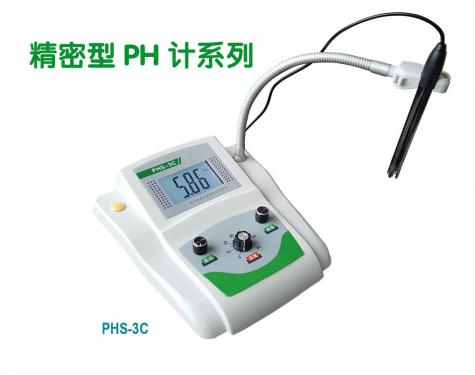1. use of instruments
phs type digital display acidity meter is a high-precision instrument used to measure ph value in laboratory. with dual functions of ph and mv, and standard e201-c composite electrode, it has quick reaction and good stability. the instrument is applicable to industrial and mining enterprises, scientific research, agriculture, medicine, teaching, environmental protection and other units, used for sampling and determination of ph value of aqueous solution and measurement of electrode potential (mv value).
2. technical performance and complete set of instruments
1. main technical parameters of the instrument:
instrument model
phs - 25
phs - 2 - c
phs - 3 - c
ph measurement range
the ph of 0.00 to 14.00
the ph of 0.00 to 14.00
the ph of 0.00 to 14.00
accuracy of ph measurement
& plusmn; 0.05 ph
& plusmn; 0.02 ph
& plusmn; 0.01 ph
the resolution of the
0.01 ph
0.01 ph
0.01 ph
mv range of measurement
0 ~ & plusmn; 1999 mv
0 ~ & plusmn; 1999 mv
0 ~ & plusmn; 1999 mv
mv measurement accuracy
& plusmn; 10 mv
& plusmn; 10 mv
& plusmn; 2 mv
the resolution of the
1 mv
1 mv
1 mv
temperature compensation range
0 ~ 60 ℃
0 ~ 60 ℃
0 ~ 60 ℃
standard buffer solution
ph4.00; ph6.86; ph9.18,
power source type
a stabilized voltage power adapter, or power cord, containing a battery that can last up to 100 hours.
installation dimensions
220 mm & times; 200 mm & times; 85 mm
the weight of the
about 1 kg
2. operating environment of the instrument:
(1) temperature: 5 ~ 40 ℃.
(2) relative humidity: ≤ 80%;
(3) temperature test solution: 5 ~ 60 ℃.
(4) power supply: 220v/50hz power supply
(5) no significant vibration and strong electromagnetic interference.
3. main parts and functions of the instrument
positioning knob: adjust the value of ph6.86 standard buffer according to the corresponding temperature during calibration.
temperature knob: sets the temperature of the solution to be tested.
slope knob: adjust the value of ph4.00 or ph9.18 standard buffer according to the corresponding temperature during calibration.
electrode socket: connect ph composite electrode (interface model: q9)
ph /mv switch: select measure ph or mv
power switch: turn on or off the instrument power supply
power outlet: connect a stabilized voltage power adapter, or power cord
iii. instrument usage:
1. preparation before instrument use:
the electrode holder can be installed in the groove on the left or right side of the instrument according to your personal preference.
unplug the q9 protection plug, plug the composite electrode into the electrode socket, and fix it to the pole rack.
plug in and turn on the switch, preheat the instrument for a few minutes.
2. instrument calibration
a. plug in the electrode and select the switch to set the ph. the positioning regulator and the slope regulator are all in the middle position. the temperature regulator moves to the corresponding corrected solution temperature.
b. after the electrode is washed and dried with distilled water, put into the first buffer solution ph=6.86 and stir to make it fully contact. after the reading is stabilized, adjust the positioning regulator to make the reading be the ph value at the corresponding temperature of the buffer solution (see attached table).
c. after the electrode is washed and dried with distilled water, put into the second buffer solution with ph=4.00 (or ph9.18) and stir to make it fully contact. after the reading is stabilized, adjust the slope regulator to make the reading be the ph value at the corresponding temperature of the buffer solution (see attached table).
the calibrated instruments should not be subject to further changes in the regulators. otherwise it has to be recalibrated. during regular use, the calibration will meet the requirements once a day.
3. measure ph value:
calibrated instruments can be used to measure the solution.
(1) the temperature of the measured solution is the same as that of the standard solution used for correction.
the electrode is inserted into the solution under test and stirred to make it fully contact. after the reading is stable, the ph value of the solution is read.
(2) the temperature of the measured solution is different from that of the standard solution used for correction.
the thermometer measures the temperature of the solution to be measured.
the electrode is inserted into the solution under test and stirred to make it fully contact. after the reading is stable, the ph value of the solution is read.
